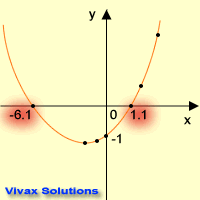Quadratic Equations
Quadratic Equations: Your GCSE & IGCSE Mastery Guide (4 Methods Included!)
Feeling a little lost in the world of quadratics? Don't worry, you're not alone! Quadratic equations are a fundamental concept in GCSE and IGCSE maths, but solving them can feel tricky. But fear not, intrepid student! This comprehensive guide will equip you with not one, but **FOUR** powerful methods to tackle any quadratic equation with confidence.
Whether you're a whiz at factoring or prefer a more formulaic approach, we've got you covered. We'll break down each method step-by-step with clear explanations and helpful examples. By the end of this tutorial, you'll be a quadratic-conquering champion, ready to ace those exams!
In this tutorial, you will learn:
- What a quadratic equation is
- How to solve by factorization
- How to solve by quadratic formula
- How to solve quadratic equations by completing the square
- How to solve a quadratic equation graphically
- How to generate quadratic equations randomly by using a programme, at the end of the tutorial for practice
- How to use Microsoft Excel in solving quadratic equations by using the formula method
Quadratic Equations
An equation in the form of ax2 + bx + c = 0 is called a quadratic equation.
E.g.
- x2 + 6x + 8 = 0
- 2x2 - 5x + 6 = 0
- x2 - 6 = 0
- x2 - 6x = 0
A quadratic equation has two solutions; that means there are two values for x that satisfy the equation. There are four different ways to solve a quadratic equation:
- Factorizing Method
- Formula Method
- Graphical Method
- Completing the Square Method
Factorizing
E.g.1
x2 + 8x = 0
x(x + 8) = 0
x = 0 or (x + 8) = 0
x = 0 or x = -8
E.g.2
x2= 6x
x2 - 6x = 0
x(x - 6) = 0
x = 0 or (x - 6) = 0
x = 0 or x = 6
E.g.3
x2 + 6x + 8 = 0
x2 + 4x + 2x + 8 = 0
x(x + 4) + 2(x + 4) = 0
(x + 4)(x + 2) = 0
(x + 4) = 0 or (x + 2) = 0
x = -4 or x = -2
E.g.4
x2 - 6x + 8 = 0
x2 - 4x - 2x + 8 = 0
x(x - 4) - 2(x - 4) = 0
(x - 4) = 0 or (x - 2) = 0
x = 4 or x = 2<
E.g.5
x
2 + 6x - 16 = 0
x
2 + 8x - 2x - 16 = 0
x(x + 8) - 2(x + 8) = 0
(x + 8) = 0 or (x - 2) = 0
x = -8 or x = 2
E.g.6
2x2 + 13x + 6 = 0
2x2 + 12x + x + 6 = 0
2x(x +
6) + 1(x + 6) = 0
(x + 6) = 0 or (2x + 1) = 0
x = -6 or 2x = -1
x = -6 or x = -1/2
E.g.7
x2 - 9/4 = 0
(x + 3/2)(x - 3/2) = 0
x + 3/2 = 0 or x -
3/2 = 0
x = -3/2 or x = 3/2
Formula Method
If ax2 + bx + c = 0, then
x = [-b ±√(b2 -
4ac) ]/ 2a
E.g.1
x2 - 6x + 8 = 0
a = 1; b = -6; c = 8
x = -(-6) ±√((-6)2
- 4(1)(8)) / 2(1)
x = 6 ±√(36 - 32) / 2
x = 6 ±√(4) / 2
x = (6
± 2 )/ 2
x = 4 or x = 2
E.g.1
2x2 - 5x + 3 = 0
a = 2; b = -5; c = 3
x = -(-5) ±√((-5)2
- 4(2)(3)) / 2(2)
x = 5 ±√(25 - 24) / 4
x = 5 ±√(1) / 4
x = (6
± 1 )/ 4
x = 1.5 or x = 1
Graphical Method
In this method, a graph is plotted for a quadratic function. The graph takes the
typical shape, known as parabola.
E.g. Solve x2 + 5x - 7 = 0
First of all, make a table for both x and y of the function.
|
x |
y |
|
-2 |
-13 |
|
-1 |
-11 |
|
0 |
-7 |
|
1 |
-1 |
|
2 |
7 |
|
3 |
17 |

Now, plot a graph of y against x. Note the points at which the curve the crosses
the x-axis. They are the solutions of the quadratic function. The solutions are:
x = 1.1 or x = -6.1
The following animation is interactive: it shows how to solve a quadratic equation by a graph; by clicking on the button, you can generate a random equation and its solutions appear at the same time. If there are no solutions - the graph being above the x-axis - instead of solutions, the word, undefined, appears in those places.
Completing the Square Method
x2 + 4x - 5 = 0
Let (x + a)2 + b = x2 +
4x - 5
x2 + 2ax + a2 + b = x2 + 4x - 5
Now, make the coefficients of x and the constant equal.
x => 2a = 4
a =2
a2 + b = -5
4 + b = -5
b = -9
(x + 2)2
- 9 = 0
(x +2)2 = 9
(x + 2) = ±3
x = -2 ±3
x
= 1 or -5
Now, in order to complement what you have just learnt, work out the
following questions:
Click the button to get the quadratic equations; solve them by all four methods
to master the techniques.